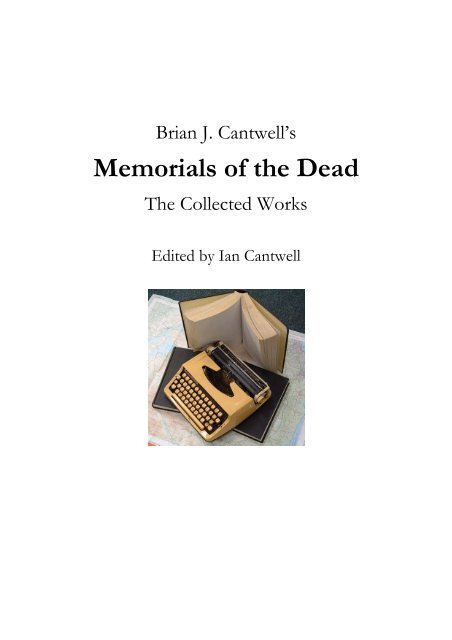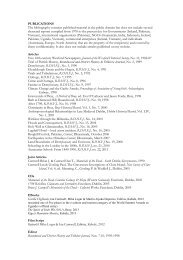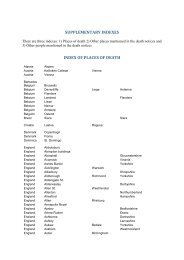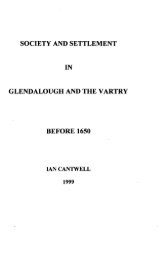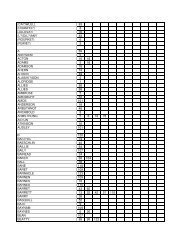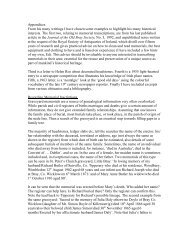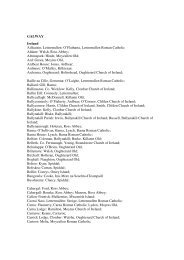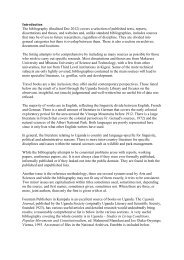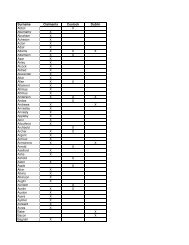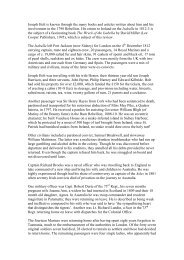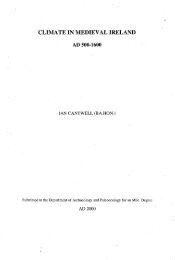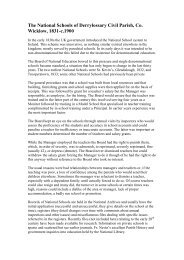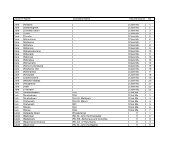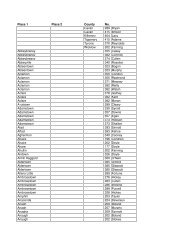Biography - Ian Cantwell
Biography - Ian Cantwell
Biography - Ian Cantwell
Create successful ePaper yourself
Turn your PDF publications into a flip-book with our unique Google optimized e-Paper software.
Brian J. <strong>Cantwell</strong>’sMemorials of the DeadThe Collected WorksEdited by <strong>Ian</strong> <strong>Cantwell</strong>
His interest in history came from an early involvement in the Royal Society of Antiquaries ofIreland, which he joined in 1943 and served as Treasurer 1946-67, he was elected Life Fellowin 1964. He also joined the Kildare Archaeological Society in 1947-8 and served as Auditor,Treasurer and Editor (1954-9) at a period when the society was at very low ebb; goodinvestment and the sale of their back catalogue ensured its survival and continuance. Hismercantile experience was invaluable since most society members were of that social classthat had little experience of financial management. He was influenced and encouraged byLiam Price, Ada K. Longfield (Mrs. H. G. Leask) and Helen Roe. He spent holidays in Co.Clare in the 1970s recording headstones with occupations and carvings. 2In the 1950s he compiled a genealogy and published A <strong>Cantwell</strong> Miscellany (1960) covering theearly history of the surname in Ireland and included a family tree. He related how after beingstuck for a long time with his great-grandfather, Timothy <strong>Cantwell</strong>, he accidentally cameacross a photo of his memorial in Glasnevin abandoned in a cupboard while visiting hismother. The information was invaluable in locating the family’s origins in Rahan, Co. Offalyand probably influenced his later research by highlighting the importance of graveyardmemorials.16 th Century Headstone to theNite of GlinworthIn 1971 The Irish Genealogical Research Society formeda sub-committee, under the chairmanship of GerardSlevin (a fellow enthusiast), Chief Herald, to “investigatethe possibility of making a comprehensive recording oftombstone inscriptions”. He contributed to thecommittee’s proposals eloquently arguing for the need totranscribe gravestones citing his experiences in Co. Clare,etc; the original meeting was about untapped sources forIrish genealogy. As at the time the family was living inGreystones, Co. Wicklow, he volunteered to make a starton the county. On being asked, c. 1972, how long itwould take to complete he said “that his grandchildrenwould not see it finished” little realizing that not onlywould he finish Co. Wicklow but would complete Co.Wexford as well.The guidelines he used were decided at the above 1971 meeting and are given in theintroduction to Volume I; the 1880 deadline was designed to cover lack of registration ofdeaths in the period 1864-80. 3 Even though later thinking pushed the date forward to 1900he kept the 1880 benchmark for consistency and maximum geographical coverage. Thevolumes introductions evolved from simple addresses and later included commentary onplace name variations, history and conditions of graveyards, headstones and people.2 The 23 sites from Co. Clare are unpublished but were typed twice c. 1980 and 1991, the latter hasadditional material, an occupational index and photos and sent to the Clare Heritage Centre and ClareCounty Library. His collection of photos was circulated to interested historians at various times (seeappendix for sample correspondence with Helen Roe) but the bulk appears to have been donated to theClare County Library in 1991. The empty envelopes, with descriptions, are in 1182/1. Photographs ofdecorated and other headstones from Clare, Wexford and Wicklow are included in this edition.3 See JIGRS Vol. 4, no. 5, pp. 515-7, 1972, for further details on procedures, what to copy, equipment andpresentation. The appendix has published and unpublished articles on procedures and advice.
published. From now on he saw the value of integrating their research and having both inone work. This was not to say that he wasn’t sometimes critical of their elitist bias in whatthey chose to record; he had most respect for Walter Fitzgerald, “…from experience I findthat he was a most reliable transcriber” (1984).Most graveyards did not call for any special comment though there is the occasional note onconditions or how to find one, such as Knockloe: ‘Access is through an iron gate, just east ofthe bridge over the River Derreen, on the main Shillelagh/Tullow road, thence across thefields in a northerly direction for approx. 1 mile. The graveyard is surrounded by a stone wallwith a stile for entrance. A large number of graves are marked by uninscribed boulders’. Inthis case he transcribed all memorials. Other problems were the access road to Yew Treegraveyard being ploughed over and Mullinacuff caused problems due to sinking and lichenencrustation.Volume IV, 1977-8, was completedduring one of the worst winters of theperiod, 1978-9. It followed the samepattern and only minor changes weremade in presentation thereafter; henow included photocopies of JMDillustrations. The reason thatGlendalough appears in this ratherthan the first volume was due to itssize and haphazard organisation, whichhe did not feel competent to undertakeearlier.In this area he received the only refusalto visit a graveyard but ascertained thatwhile there were no modern memorialsthere were slabs with prehistoric andDecorated headstone of the Passion, Miltown Malbay,Co. ClareEarly Christian carvings. He also noted the recent destruction of a burial mound atCreghorn, a tradition on Goldenfort, and the granite headstones between Dunlavin andBoystown. The latter was one of the more difficult sites to transcribe, though Kilranelagh at1,000’ was no easier due to its exposed position. Snow & ice prevented transcription inHollywood C. of I. and Knockrigg was much overgrown. The inclusion of the CoronationPlantation Obelisk was due to its age and vulnerability. His critical comments on conditionscontinue: Donoughmore C. of I. due to the graveyard being ‘tidied up’, which resulted in thememorials being stacked in a pile and therefore unreadable, the destruction and near loss ofa Church 1815 memorial to the Tyntes in Dunlavin R.C. and the possible conversion ofDunlavin Old to an ‘amenity area’.Irish Genealogical Research Society:In this period he indexed the IGRS holdings of unpublished graveyards in the GenealogicalOffice in 1979-80.
Wexford:Having completed Wicklow he was contacted by the Catherine O’Rourke, County Librarian,Wexford Library Service who offered to cover his transportation expenses and costs ofreproduction and binding in conjunction with the Wexford County Council. Thisenlightened sponsorship gave him the freedom to travel and record the whole county, whichalmost certainly would not have happened otherwise due to rising petrol costs and increasedtravel distances. The county has always had a greater tradition of historical research withmany more local historians with whom he built up links and who also contributedtranscriptions and gave invaluable assistance. The next five volumes are more of acooperative effort and the anticipation felt by many as he worked across the county comesacross in newspaper reports of the time. No doubt his work influenced the County Council,Churches and local communities in keeping their graveyards in good order and encouragedthe many Parish Histories published since.The credits roll as follows: In North Wexford he was greatly assisted by J. C. Warren ofCamolin who gave him much invaluable advise on defunct graveyards none of which hadheadstones with the exception of Kilcomb, which was inaccessible, as well as introducinghim to an unpublished history of T. G. Reynolds of Gorey and clearing vegetation inBallyduff and Toome Old. He utilized registers in Christ Church, Gorey, and Godkinmemorials thanks to Archdeacon Parker and N. J. Godkin, Half Moon Bay, B.C. Canada,respectively. Help was also received from the Lazenby family of Kilcashel.In East Wexford he received a lot of useful information from Fr. Seamas DeVal, assisted inone case by Miss Mary Keane, Oulart, Canon Grant and Sam Coe, Wexford, and theWexford Municipal Authority who provided keys for closed graveyards under their care. MaiMcElroy, Bernard Browne, Nicky Furlong and other members of the Old Wexford Societyorganized the clearance of St. Selskar’s to which he returned to make a supplement andfinally Mr. Scallan, Celtic Laundry, cleared St. Magdalen’s, Wexford.In South East Wexford through the good offices ofMai McElroy he was able to use Dr. R. J. and M. W.Hetherington’s (of Birmingham) inscriptions ofBannow, other contributors of transcriptions werePatrick Sills, Murrinstown, and Christina Whelan,Ballyteigue. Tom Williams, Taghmon, gave himinformation on that area, as did Francis Leigh,Wellingtonbridge, on Ballylannan, Michael Furlongarranged a visit to Johnstown Castle’s privategraveyard. Meanwhile, Piercetown Graves Committeeand Murrinstown Youth Club cleared Kilmacree,Drinagh and Kildavin prior to his visit.Decorated headstone, Glenealy, Co.WicklowIn South West Wexford his main assistance came fromSean Cloney, Dungulph Castle, they became closefriends and soul mates, and shared many evenings inwide-ranging conversations. The castle became his
ase for most of this part of the county. Lt. Col. D. J. McLoughlin, Quartermaster CurraghCommand and Paddy Burke, Caretaker, gave permission and assistance at Duncannon Fort.Jarlath Glynn, Wexford, and Bernard Browne, Mill Quarter, gave information.In West Wexford he renewed acquaintance with Sean Cloney while Bernard Browne keptthe flow of information going. Thomas Hayes, Kilmore, gave directions to Corlican. GeorgeLett, Enniscorthy, provided a list of some internments at Killalligan. Rev. John T. Dunne,Leeds, gave permission for his transcription to be the basis for Rossdroit, and Mike Nolan,Enniscorthy, provided a copy of the 1905 Schedule of Exemptions from St. John’sEnniscorthy.In the final book, Volume X, he used church memorials collected by Evelyn Miller,Rathaspeck, and Patrick Sills who transcribed part of Rathaspeck and all of Kilrane. TheNolans, Ballynastraw, towed his car out of deep mud at Ballyhuskard, he recommendswaders. Back in Wicklow he received access to notes and reports from Pat Power, Jim Reesand Bobby Tyrrell, Arklow, covering the Howard Vault, Kilbride and St. Mary’s, Arklow.The introductions contain the name of site (and variations), church dedications (if any),condition of graveyard, whether easy to transcribe and what any problems were, variousnotes on history of graveyard or memorials from Leslie or Grattan Flood, etc., references todecorated headstones and memorials from Leask, Potterton and JMD. He alwayscomplemented a well looked after graveyard and gave credit to the individuals, localcommunities and community organizations that kept their graveyards in good order. 4Generally speaking the south and west of the county had less troublesome graveyards thatthe north and east. Whereas the former may have had 2-3 with major problems, the latterhad about six.Volume V, 1979-80, follows the procedures of the previous volumes. Due to Wexford’s longinterest in the 1798 Rebellion he included a list of memorials with 1798-9 as a supplement tothe Occupational index. 5 In Askamore he includes some biographical information on JamesCorcoran who was killed during the 1916 Rising, a historical note on Ballinclay (Quaker),notes memorial tablets at Ballycanew, silver collection of Camolin, burial continuity atDonoughmore Old, Reynold’s manuscript history of Gorey, the lack of 19 th centurymemorials in Kilcashel, the Byrne school of decorated headstones at Kilcavan, the housevault of Kilrush C. of I., and memorials to servants at Prospect.Critical comments included the re-alignment of memorials at Balindaggin Old,Castledockrill, Craanford, etc., which always destroys headstone groupings, the loss ofinterior memorials in Ferns R. C. when the church was replaced, neglect and defacement atKilrush R.C., the deplorable stacking of memorials face down at Leskinfere C. of I. Therewere transcription problems at Ballymore, which was overgrown and part was nevertranscribed, Clonattin Old was only partially done as after making way through a haggard,though a field for ¾ mile, across a barbed wire topped bank he found that at least ten were4 He also noted any evidence of destruction, ‘tidying up’ and ‘modernization’.5 This is only in Volume V, published in The Past, 1980. Deaths, 1798-9, Volumes VI-X are published inThe Past, 1992.
Probably his favourite epitaph was to Anthony Reynolds, Kinnagh: “He was faithful to hisemployer and although a Miller was an honest man.”Conditions, like the South East, were good with the exceptions of overgrowth and lichen atBallyhack, lichen at Templetown and Whitechurch. He noted modernisation at Ballycullaneand Horeswood (“I’m glad to report, for once, the memorials were not broken up anddestroyed … but suffering effects of the weather”).In Volume IX, 1985, he quotes Hore on Ardcandrisk, comments on the Richards ofAskinvillar, gives a reference to the King of Sardinia in Ballyanne, notes veneration at theBrenan memorial at Ballybrennan, Ballyhogue’s bell, Clonmore’s 150 th anniversary, Cogleyand Quigley variants at Clonmore Old, Quaker burials at a rath at Corlican, Penzance,Cornwall and the Beatty double-burial myth at Killurin, dancing on Reynell’s slab at Monart,Medieval memorials at New Ross, decorated headstones at Rosbercon and Schedule ofExemptions at St. John’s Enniscorthy.Conditions were good in general. He approves of the fact that Glynn’s and Kiltealy’smemorial tablets were not removed during renovations. Modernization is not a newphenomena, From Leslie there’s an 1832 quote on Killane: “What a pity to find ecclesiasticsso little regardless of venerable architectural remains”. Killalligan’s private graveyard,surrounded by a concrete block wall, was “dangerous to enter the enclosure without a stepladderand a plank”. St. Mary’s, New Ross, prior to clearance by a Youth EmploymentScheme had been the home of wild mink,Having completed the two counties he transcribed some sites, which he had been unable todo, that had been cleared, two graveyards that had been overlooked, Kilrane andBallyhuskard Old and three Churches that he could not gain access to, Clonmore, Monartand Templescoby. Conditions, because of clearances were much improved though inBallyhuskard Mr. Nolan had to tow out the car mired in deep mud outside the entrance. Histhird attempt to visit Chapel, Co. Wicklow, was defeated by ‘briar-topped high banks,flooding and brambles’. This is the basis of the supplementary Volume X, 1986. From othersources he included transcripts of three churchesand two graveyards and a correction. It includes a‘Memorandum on Decorated Headstones andChurch Memorials’ that describes the work ofFlood, Leask, Leslie, Loeber, O’Farrell, andPotterton and adds a few comments on JMD. Hehad also became critical of his original indices andfelt that not only would a composite index of allten volumes be useful but it would also give himthe chance of correcting the original volumeindices.Partially obstructed headstone atBallintemplePartially obstructed headstone. ThePassion, Ballintemple, Co. Wicklow,1763In this volume there is an 1829 rental ofEnniscorthy 6 with biographical notes of some ofthe tenants taken from Pigot’s 1824 Directory, Leslie and Grattan Flood (includes the 18336 Registry of Deeds, 566104. The credit for its discovery belongs to Eric McAuliffe.
correspondence between Bishops Keating and Elrington) and a list of Fern’s Protestants‘murdered by Rebels’ from Jottings from a Parish Register by Canon Thomas B. Gibson, 1898. 7Both were included due to their rarity and importance though they do not strictly fall withinhis remit.Having completed Wexford he was approached by Carlow County Council as to whether hewould care to cover the county in conjunction with Muintire Na Tire who were running agraveyard-recording scheme in the county at the time. He thought about it but decidedagainst on the grounds the work was already in capable hands and that the crossingbackwards and forwards over the Wicklow Gap in winter, the best time for transcribing, wasnot to be recommended. From 1987 his workload in the Irish Wildbird Conservancyincreased to 3-4 days a week after its transfer from Greystones to Monkstown. The newcomputer’s databases of the time, needed for accounts and membership records, were still abit experimental and often full of flaws and frustrations.Dublin:In his spare time he continued recording in South Dublin but since there are many otherindividuals and groups working on graveyards in the city and county he concentrated onchurches. These he felt were underestimated and often more vulnerable, many have beendestroyed or been changed to secular use in the previous forty years. It was while trawlingthrough these that he found the only family connection, a panel listing his grandfather’sname, Thomas Francis <strong>Cantwell</strong>, as a bell donor, at Mount Argus and commented, “It wasgood business”.This resulted in his eleventh and final volume published in 1990, 8 which covers 76 churchesand graveyards. 9 The occupational index is comprehensive and includes miscellaneouscauses of death and memorials dedicated to various Parish societies. Most churches visitedwere modern Roman Catholic reflecting the expansion of the city from the Victorian period.By contrast some Church of Ireland churches were not included since many have beenconverted to secular use in recent rationalization of parishes churches.In the introductions he gives brief notes on foundation dates, constitution, dedications andparish histories. He makes occasional connections between Dublin and Wexford or Wicklowfamilies, there are comments on church services in St. Bartholomew’s, Clyde Road, theMagan family of Crinken, political censorship at Christ Church, ‘Kingstown’, history ofMariner’s Church, the Pauper’s Graveyard at Loughlinstown, Patrick Doyle’s 1916 memorialat Milltown, Old Connaught, the Cornwall window and Roche and Dean Grady families atSt. Brigid’s, Stillorgan, the O’Neal stone at Old Connaught. He obtained help from EvaO’Cathaoir on Loughlinstown Pauper’s Graveyard and Rev. Canon John Crawford on St.Kevin’s, S.C.R., and was helped in St. Brigid’s, Stillorgan, by Tommy Rath, Sexton, and in St.Andrew’s by Billy Dawson, Sexton.7 Copy of book donated by a descendent, Ms. Margaret Williams, Canada.8 The editor’s contribution to volume XI was due to convenience, it was easier for me to visit thesechurches on Sunday mornings.9 Kilgobbin Old, 57 memorials & 263 names was transcribed but he notes that ‘Rejected – per M Egan’(NA 1182/1/33).
Overall:In fourteen pages of analysis he estimated that over twenty-five years, 1966-1990, he visited546 sites, transcribed 24,392 memorials with the names of 67,297 people on 102 notebooks 10and is broken down as follows:County Sites Memorials Names PublishedClare 24 613 1235 NoneCork 9 91 188 NoneDublin 76 1712 4694 AllGalway 1 101 243 AllKildare 4 189 437 ThreeSligo 1 36 57 NoneWexford 283 13280 41167 AllWicklow 157 7482 20672 AllPercentage Sites, Memorials and Names6050% Sites% Memorials% Names40Percentages3020100Clare Cork Dublin Galway Kildare Sligo Wexford Wicklow% Sites 4.3 1.3 13.7 0.4 0.7 0.2 51.2 28.4% Memorials 2.3 0.4 7.3 0.9 0.8 0.2 56.7 31.6% Names 1.8 0.3 6.8 0.4 0.6 0.1 60.1 29.9CountiesEpilogue:10 Averaging 44.67 memorials per graveyard & 2.76 names per memorial. NA 1182/1/34. The first (1966-70) 2 nd (1970-2) and 102 nd (1990) are the only survivors, his policy was to dispose of when finished.Another two have transcripts from JMD, etc.
Brian J. <strong>Cantwell</strong> passed away peacefully, while surrounded by his family, after a short illnessat Our Lady’s Hospice, Dublin in January 1992. His ashes were scattered at his favouriteplaces in Wicklow and to the four winds of Cich Cualann’s 11 summit.Since then some of his friends, comrades and fellow transcribers have also passed on to theireternal reward. “My House has many Mansions”, hopefully includes a permanentconvocation of historians, a library where the angel librarians are only run off their wings ingetting books, a snug with armchairs round an oak fire for conversations deep into theeternal night…Brian J. <strong>Cantwell</strong>11 Great Sugar Loaf, Co. Wicklow
AcknowledgementsI am indebted to Rosemary Ffolliott and the Committee of the Kildare ArchaeologicalSociety for permission to include published transcriptions of Cos. Galway and Kildare fromthe Irish Ancestor and Journal of the Kildare Archaeological Society in this publication. I am alsoindebted to the Old Bray Society for permission to publish an article extract from the BrayHistorical Record. Lastly I am indebted to the National Archives for permission and facilitatingthe scanning of transcriptions, photographs, correspondence and other images from the<strong>Cantwell</strong> Archive. I wish to thank the staff of the Wexford and Wicklow County Librariesfor assistance in tracking down articles for the bibliography.


